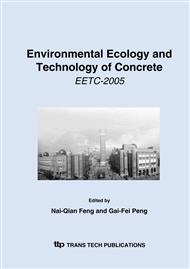p.521
p.528
p.536
p.543
p.550
p.556
p.561
p.567
p.572
Effects of Styrene-Acrylate Emulsion on the Damping Ability and Hydration of Cement Matrix
Abstract:
Cement mortar of high damping ability has been maded by using styrene-acrylate emulsion as an admixture. The addition of styrene-acrylate emulsion causes the loss tangent of plain cement mortar to increase at all temperature (-30-30 °C) and frequencies (0.1-2.0 Hz), and the loss tangent increase is particularly large at 15-30 °C, even up to 0.25 at 30 °C and 0.5Hz due to the glass temperature of styrene-acrylate emulsion, although the storage modulus of cement mortar with this admixture decreases at all temperatures and frequencies, however, for the loss modulus, which serves as an comprehensive figure-of-merit for the vibration reduction ability, styrene-acrylate emulsion may dramatically increase it. The X-ray diffraction (XRD) and infrared (IR) spectrum analysis have provided evidence that styrene-acrylate decelerates the hydration of cement paste.
Info:
Periodical:
Pages:
550-555
Citation:
Online since:
January 2006
Authors:
Price:
Сopyright:
© 2006 Trans Tech Publications Ltd. All Rights Reserved
Share:
Citation:


